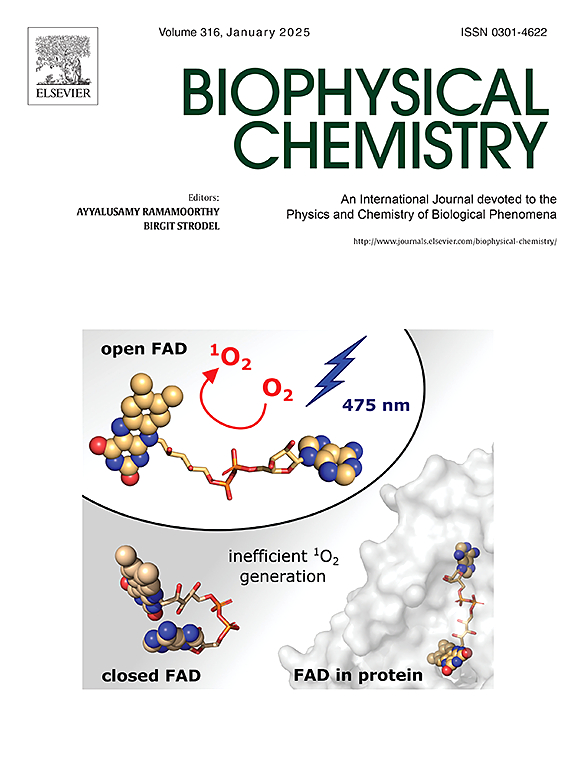Degree–based topological indices, NMR chemical shifts, chemical reactivity, molecular dynamics and DFT analysis of 1,4-Methanoazulene-9-methanol, Decahydro-4,8,8-trimethyl-, [1S-(1α,3aβ,4α,8aβ,9R)]
IF 2.2
3区 生物学
Q2 BIOCHEMISTRY & MOLECULAR BIOLOGY
引用次数: 0
Abstract
This study aims to comprehensively analyze the structural, vibrational, and electrical characteristics of 11,4-Methanoazulene-9-methanol, decahydro-4,8,8-trimethyl-, [1S-(1α,3aβ,4α,8aβ,9R*)] (MMDT) with a focus on its potential as a therapeutic agent for liver cancer. The compound was isolated from Hybanthus enneaspermus using Soxhlet extraction, followed by Gas Chromatography-Mass Spectrometry (GC–MS) analysis. The structure optimization and vibrational frequency assignments were done using Density Functional Theory (DFT) method with the B3LYP/6–311++G (d, p) basis set. Natural Bond Orbital (NBO) analysis was conducted to explore intramolecular and intermolecular interactions, along with the first-order hyperpolarizability. Electronic properties such as the energy gap and molecular electrostatic potential (MEP), were calculated to anticipate reactive sites for electrophilic and nucleophilic attacks. This is crucial in understanding the compound's reactivity in biological systems. TD-DFT was employed to simulate UV–visible spectra and compared with experimental values. Additionally, the theoretical FTIR spectra were correlated with experimental data, with potential energy distribution (PED%) providing detailed vibrational mode analysis. HOMO and LUMO orbitals were evaluated in the gas phase, revealing key energy parameters. 1H and 13C NMR chemical shifts have been properly assigned using the DFT for structural characterization. QSPR/QSAR analysis is made simpler by determining a few topological indices for the MMDT. This study provides a novel computational framework for MMDT paving the way for faster, cost-effective and the Molecular docking studies revealed stable interactions between MMDT and liver cancer-related receptors, with favourable binding energy values along with Ramachandran plot confirmed the stability of the protein-ligand complex could be a promising candidate for liver cancer treatment.

1,4-Methanoazulene-9-methanol, Decahydro-4,8,8-trimethyl-, [1S-(1α,3aβ,4α,8aβ,9R)] 的基于度的拓扑指数、核磁共振化学位移、化学反应活性、分子动力学和 DFT 分析
本研究旨在全面分析11,4-甲烷偶氮烯-9-甲醇,十氢-4,8,8-三甲基- [1S-(1α,3aβ,4α,8aβ,9R*)] (MMDT)的结构、振动和电学特性,重点研究其作为肝癌治疗剂的潜力。采用索氏提取法从棘豆中分离得到该化合物,并采用气相色谱-质谱联用技术对其进行分析。采用密度泛函理论(DFT)方法,以B3LYP/ 6-311 ++G (d, p)基集对结构进行优化和振动频率赋值。利用自然键轨道(NBO)分析了分子内和分子间的相互作用,以及一阶超极化率。通过计算能隙和分子静电势(MEP)等电子性质来预测亲电和亲核攻击的反应位点。这对于理解化合物在生物系统中的反应性至关重要。采用TD-DFT模拟紫外可见光谱,并与实验值进行比较。此外,理论FTIR光谱与实验数据相关联,势能分布(PED%)提供了详细的振动模式分析。在气相中对HOMO和LUMO轨道进行了评估,揭示了关键的能量参数。1H和13C核磁共振化学位移已适当分配使用DFT结构表征。通过确定MMDT的几个拓扑指标,使QSPR/QSAR分析变得更简单。这项研究为MMDT提供了一个新的计算框架,为更快、更经济地实现MMDT铺平了道路。分子对接研究揭示了MMDT与肝癌相关受体之间稳定的相互作用,有利的结合能值和Ramachandran图证实了蛋白质-配体复合物的稳定性,可能是肝癌治疗的有希望的候选者。
本文章由计算机程序翻译,如有差异,请以英文原文为准。
求助全文
约1分钟内获得全文
求助全文
来源期刊

Biophysical chemistry
生物-生化与分子生物学
CiteScore
6.10
自引率
10.50%
发文量
121
审稿时长
20 days
期刊介绍:
Biophysical Chemistry publishes original work and reviews in the areas of chemistry and physics directly impacting biological phenomena. Quantitative analysis of the properties of biological macromolecules, biologically active molecules, macromolecular assemblies and cell components in terms of kinetics, thermodynamics, spatio-temporal organization, NMR and X-ray structural biology, as well as single-molecule detection represent a major focus of the journal. Theoretical and computational treatments of biomacromolecular systems, macromolecular interactions, regulatory control and systems biology are also of interest to the journal.
 求助内容:
求助内容: 应助结果提醒方式:
应助结果提醒方式:


